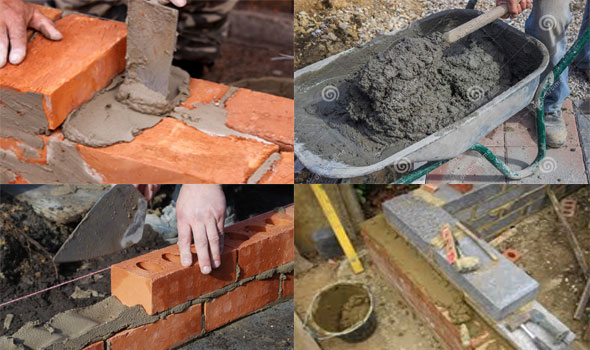Types of Mortars in Building Construction
- Concrete Cost Estimator
- Concrete Continuous Footing
- Landscape Bidding and Estimating
- Construction Cost Estimating
- Concrete and steel cost estimation
- Construction Cost Estimate Breakdown
- Construction Estimating Worksheet
- Home Construction Cost Estimate
- Estimate Pricing Sheet
- Sheet for General Contractor
- Construction Cost Estimate
- Labor Materials Cost Estimator
- Masonry Estimating Sheet
- Sheet for Building Contractor
- Construction Schedule Bar chart
- General Cost Estimator Sheet
- General Construction Estimate
- Building and Road Estimating Sheet
- Detailed expense estimates
- Door and Window Takeoff Sheet
- General Construction Cost Estimating Sheet

In building construction, various types of mortars can be found depending on the types of uses, binding material, density as well as special purposes for which it is utilized.
Mortar stands for a operable paste that is formed by including necessary amount of water to a alloy of binding material (also known as matrix) and fine aggregate (also known as adulterant). This plastic paste can easily grip building materials like stone or brick together.
Types of Mortars found in Building Construction - Types of mortars depend on the following factors:
1. Nature of application
2. On the basis of binding material used
3. Bulk density
4. Special purpose mortars
Types of Mortars depend on Nature of Application: Depending on the nature of application, the following types of mortar exist.
1. Brick or stone laying mortar
2. Finishing mortar
3. Bricklaying or Stone Laying Mortar
Usually, in masonry walls, the structural units like stones or bricks are affixed together through mortar. Here, the ratios of ingredients are settled on the basis of binding materials types.
Finishing Mortar: Finishing mortar plays an important role for pointing and plastering works. In case of normal type of plastering, cement or lime mortar is applied. To enhance the look of the building, finishing mortar is applied with architectural effects. The mortar that is applied for giving decorative finishing, should contain superior strength, mobility and resistance capacity for combating natural forces like like rain, wind, etc..
Types of Mortars on the basis of Binding Material Used: In mortar, Binding material is very important. The quality, stability and strength of the mortar are subject to the quantity and quality of binding material used. Mortars can be categorized on the basis of the binding material used :-
Cement mortar, Lime mortar, Gypsum mortar, Gauged mortar, Surkhi mortar, Aerated cement mortar.

Cement Mortar: Here, cement is applied as binding material and sand as adulterant (fine aggregate). The ratio of cement and sand is settled on the basis of the stipulated strength and working conditions. Cement mortar will provide high strength and resistance against water. The ratio of cement to sand may differ from 1:2 to 1:6.
To read the complete article, visit theconstructor.org
- Application of concrete calculator
- Roofing Calculator can streamline the roof estimating process
- House construction cost calculator
- Engineering column design excel spreadsheet
- Material Estimating Sheet with Excel
- Materials List and Cost Estimate Worksheet
- Concrete Slab Estimating Calculator Sheet
- Common types of foundations for buildings
- Online calculation of construction materials
- Estimating with Excel for the Small Contractor
- Concrete Beam Design Spreadsheet
- Virtual Construction Management app for construction
- Autodesk’s Project Skyscraper
- Reed Construction’s Reed Insight
- Manage your construction project documentation
- Costimator, the popular cost estimating software
- On Center Software for construction professionals
- Free Construction Estimating Software
- Plumbing Calc Pro
- Cost Estimate Worksheet
- HVAC Piping Quantity Takeoff Worksheet
- Construction Estimating Software Sheet
- Estimate Cost Templates
- Construction Punch List
- Construction cost estimating template consisting estimating basic
- Gantt Chart Template for Excel
- Download Civil Engineering Spreadsheets with Verification
- The Building Advisor Estimating and Budgeting Worksheet
- Spreadsheet for design of concrete bridge
- Construction Estimating Software Free








